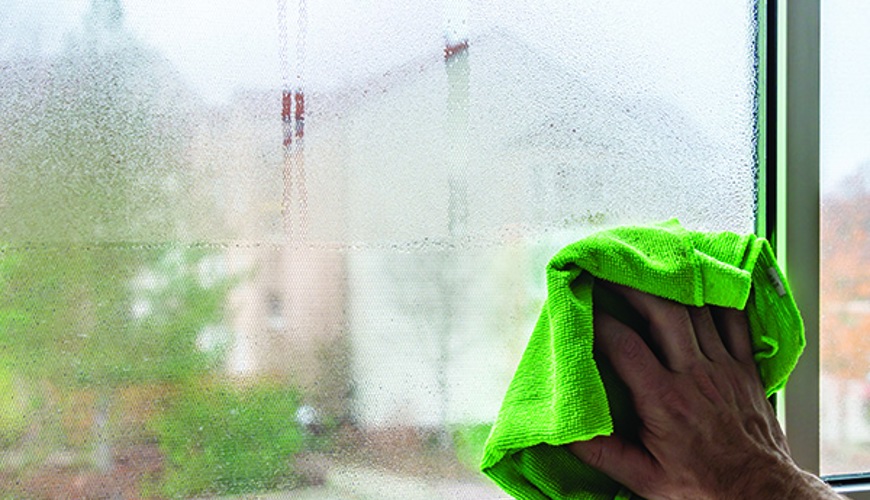Our tips will help you to keep your home free from damp and mould.
Damp and mould
There’s always moisture in the air in your home, even if you can’t see it. Moisture can contribute to creating damp and mould, and it’s important to take steps to reduce the risk of that happening.

If you’re concerned about damp or mould issues in your home, don’t hesitate to contact us. We can book an inspection of your home, and talk you through any concerns you may have. You can download a leaflet about damp and mould [PDF], and our damp and mould policy [PDF] explains our approach to looking after your home.
Dealing with damp and mould
- Condensation
- Reducing condensation
- Improving ventilation
- Heating your home
- Other causes of damp and mould
Condensation
If the air in your home becomes too cold or you create too much moisture – for example from cooking, showering or laundry – condensation will appear.
Condensation is the main cause of damp and mould in homes. If it appears on windows or doors, wipe it dry immediately to prevent mould forming.
Condensation tends to form on cold surfaces or areas in your home where this isn’t much air movement. This can include windows, patio doors, corners of rooms and small spaces behind furniture. It’s a good idea to make sure there is at least a 5cm gap behind furniture to give air room to circulate.
If you are concerned about damp or mould in your home, please contact us immediately for further advice and support.
Reducing condensation
When cooking food in saucepans, always cover them with a lid to prevent excess moisture escaping into the air.
Where you can, dry your clothes outside. In colder or wetter weather, try not to dry clothes directly on radiators as this can cause excess moisture. Drying clothes on a standing airer in one damp-free room and opening the window, where safe to do so, will reduce the moisture in your home. If you plan to buy a tumble dryer, use an external vented one.
When running a bath, a way of getting rid of extra moisture is to put a small amount of cold water into the bath first (before adding the hot water). Wipe up excess moisture: after a shower or bath, wipe down the tiles and the bath/shower to prevent that water from dispersing into the air. Keep the bathroom door closed and open the window after you shower – especially if your showers/baths last longer than 30mins.
Consider using a dehumidifier. A dehumidifier is an electronic device that works by extracting the excess moisture you cannot see. It captures it in a container as water, which can then be emptied down the drain. Dehumidifiers can be purchased at most high street retailers.
Improving ventilation
If your windows have trickle vents, open them when you can – and especially when you are cooking, bathing or drying clothes.
When you’re cooking or bathing, shut the door. This will prevent condensation from forming in the rest of your home. And if you’ve got an extractor fan in your kitchen or bathroom, use it to remove excess moisture from the air.
If your home has ventilation bricks or vents, don’t cover them up – they are important to help air circulation.
Make sure you don’t overfill your cupboards or wardrobes – it’s important to leave enough space for air to circulate. If you can, drill small ventilation holes in the back of furniture like wardrobes. This will reduce the opportunity for mould and condensation to form inside them.
Heating your home
Keeping your home a little warmer can reduce condensation and mould in your home. In cold weather, it’s best to keep the heating on low all day, even when no-one is at home. This will prevent condensation from forming.
Insulating a loft is a great way of keeping your home much warmer whilst lowering your heating bills. When we visit your home to carry out what we call a stock condition survey, we will check the insulation in your home, and arrange to increase it if required.
Try not to put furniture in front of radiators. If that can’t be avoided, leave a small gap between the furniture and the radiator, to allow air to circulate – this will reduce the amount of heat that gets absorbed by your furniture.
If you’re struggling with energy costs, our advice on utility bills could help.
Other causes of damp and mould
Condensation is not the only cause of damp. If you have damp and mould on your ceilings, near pipework or along the top of your skirting board, one of these issues may be the cause:
- Leaking pipes, waste or overflows
- Rain seeping through a damaged roof or guttering
- Damp due to damaged brickwork.
If your home already has a small amount of mould caused by condensation, it’s a good idea to treat the mould first. After this, focus on dealing with reducing condensation in your home. This should stop the mould from reappearing.
To remove the mould we would recommend using an appropriate mould and mildew cleaner. Wash and dry any mouldy clothes or fabrics and shampoo carpets. After treating, use anti-mould paint on the affected area. Do not put ordinary paint or wallpaper on top of the anti-mould paint.



